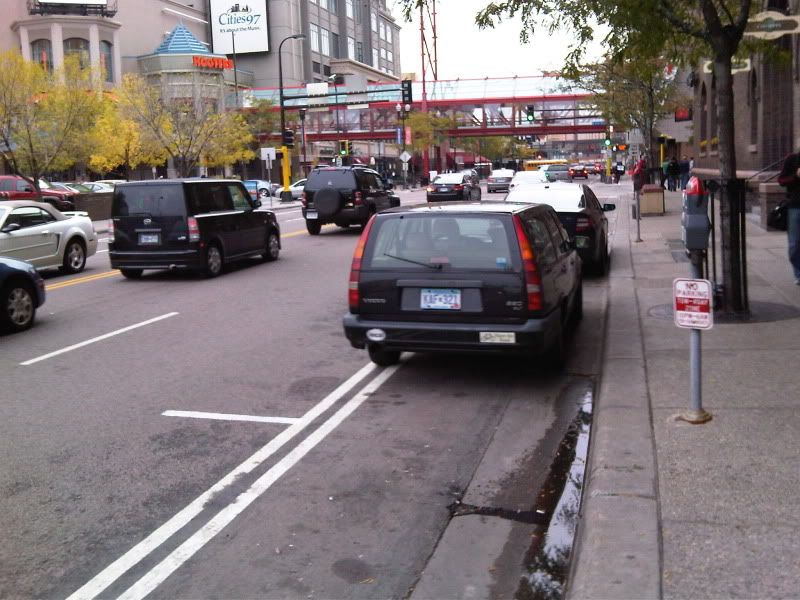 |
| [White plastic things!] |
Am I turning into a crappy plastic objects fetishist? Recently in China, a woman started a DIY traffic calming movement by tying a sex doll to a tree at a dangerous intersection. I guess the idea is to get (horny male) drivers to slow down and pay more attention. I’m envisioning a future where I run around the city disbursing traffic cones with a a “real girl” doll strapped to my back so that sexually unsatisfied men don’t run me down with their cars.
 |
| [Maybe we could get Sexworld to sponsor the next 1st Avenue pedestrian improvement?] |
That’s why I was happy when Minneapolis announced a few years back that they were going to build a cycletrack down First Avenue. Despite the protestations of business owners concerned about delivery trucks, the city went ahead with the project.
 There was only one problem. They did a half-assed job. Instead of a clearly marked and separated bike lane, they just applied some paint between the parked cars and the curb. They also made the parking lane time-sensitive, so that during rush hour the row of parked cars disappears entirely. (That’s normal on many streets.)
There was only one problem. They did a half-assed job. Instead of a clearly marked and separated bike lane, they just applied some paint between the parked cars and the curb. They also made the parking lane time-sensitive, so that during rush hour the row of parked cars disappears entirely. (That’s normal on many streets.)The problem was that, without a some sort of clearly marked area to inform people where the cycle track was, nobody really knew what to do. People parked right in the middle of the bike lane, so the city put up more signs. People still parked in the middle of the bike lane, so the city put up some flashing electronic signs that makes First Avenue seem like Las Vegas in a kaleidoscope.
Even the current signage funhouse doesn’t always work. You’ll still find people parked in the middle of the bike lane, people who are presumably illiterate or wearing two pairs sunglasses with a sombrero pulled down over their eyes or something. Until those plastic thingies appeared the other day, even the most ardent bike activist would admit that the First Avenue cycle track was a quasi-fiasco.
Minneapolis isn‘t alone in being reluctant to commit to the whole posterior. I’ve covered St Paul’s biggest bike debacle, the Jefferson Avenue bike boulevard, like a blanket in January. It's not a heartwarming story. And the way that it turned out, this bike boulevard should be probably only be labeled a “bike boulevard,” in the same way that Velveeta isn't really cheese.
 |
| [The Jefferson Avenue "test median.] |
 |
| [Ha.] |
I don’t want to be too hard on the Twin Cities. Both of these projects were something new. Both projects were politically difficult. Change is hard! Changing behavior takes a long time. Shifting prioities away from a slavish obsession with the automobile is what they call “a process.” That means that it doesn’t happen all at once. Getting people to bike and walk more is a matter of developing habits literally one step at a time.
At the same time, when faced with a difficult problem, cities are often tempted to compromise. Planners and city leaders end up torn between the politics of compromise and well-designed engineering. It seems that, much of the time, cities make so many compromises that they undermine the very thing they were trying to do in the first place. Sometimes, the perfect is the enemy of the good. Sometimes, you either do it right or you make a complete mockery of the very notion of urban planning. Sometimes, either you build a decent cycletrack that everyone can understand intuitively, or you compromise and construct a bicycle bewilderment with cars parked willy-nilly underneath a flashing LED circus filled with fine print. Then, two years later, you go back and gradually add in some thin white plastic things that you should have installed in the first place, and everyone on the street goes “Oh! That’s what its supposed to look like.”
I know which I prefer...
Update:
A report on white plastic things in Portland that got hit by cars and destroyed. TWICE.

4 comments:
Meanwhile in Chicago...
http://www.suntimes.com/news/metro/14268027-418/mayor-emanuel-adding-protected-bike-lanes-in-loop.html
https://www.cityofchicago.org/city/en/depts/cdot/provdrs/bike/news/2011/jun/city_s_first_protectedbikelaneinstalledonkinzie.html
http://gridchicago.com/2011/waving-hello-to-jackson-a-protected-bike-lane-that-undulates/
I hope those bollards (the wavy tube thingies) work better for you on First Avenue then they have in Portland; here, in some locations they've been a bit of a bust.
Those are the same things that have been used to create fake bumpouts at 44th Street and Cedar Ave in South Minneapolis. They work for about a week at a time, until you find a pile of them on the boulevard.
Good stuff, but the addition of candlestick bollards only brings 1st Ave N up to three-quarters ass. The other big unresolved problem is that it's difficult to turn left from the cycle track. You're supposed to install bike boxes to solve that issue, which Mpls did half-assedly, without the green paint necessary to allow cyclists in the track to actually see the bike boxes. There was a survey a while ago about this issue, not sure what happened to it. I know it hasn't been done on the Hawthorne end of the facility, maybe they've implemented it at the part where they're "experimenting" with functional features.
Post a Comment